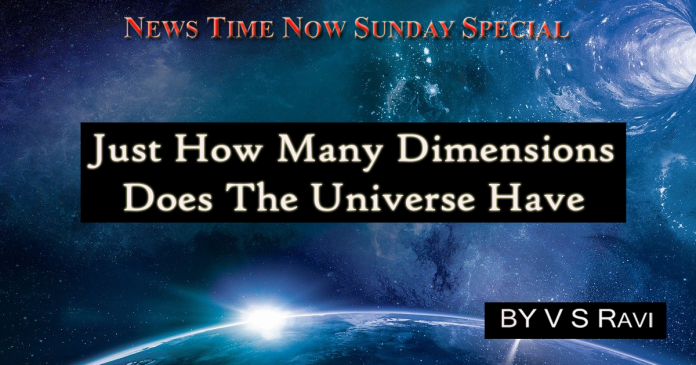Till the beginning of this century most physicists believed in the existence of only three dimensions. However, recent advances in the physics of fundamental particles and their forces would appear to indicate that there are (or were) originally several other dimensions, most probably eight, including time, which is regarded as the fourth dimension. Though the idea that the universe we perceive is but a fragment or a section of a much larger structure involving many dimensions seems paradoxical and bizarre, some of the world’s leading physicists are have bee exploring the implications and consequences of such a possibility. They believe that the concept of subatomic world would have meaning only in the context of a multidimensional universe.
More than 8 decades ago a relatively obscure German physicist proposed a remarkable theory of electromagnetism. Electromagnetic forces govern the occurrences of a vast range of everyday phenomena from radio and electronics to the chemical bonding of atoms, and this force is usually described in terms of a field permeating through space. However, the German physicist Kaluza had been influenced by the success of Einstein’s work on another force–gravity. Einstein had explained gravity not as a field of force but as a geometrical phenomenon. Einstein had described the gravitational field as a distortion of space and time i.e. a spacewarp.
Similarly Kaluza also suggested that we should think of an electromagnetic field as really part of a gravitational field in a “four dimensional space” making electromagnetism a spacewarp in the fourth dimension. This would mean that radio waves could be viewed as ripples in the extra unseen dimension. Because physicists had already learned that space and time are closely interwoven, they had to regard time as the fourth dimension. Since Kaluza had suggested another dimension of space, there would be in effect five space-time dimensions in all. Instead of outlining a concept involving three space dimensions and one time dimension, Kaluza had come out with a five dimensional theory of gravity. Kaluza was also able to squeeze the electromagnetic force into Einstein’s theory of gravity by introducing his fifth spatial dimension.
Though Kaluza did not have any experimental proof people could not brush aside Kaluza’s theory as mumbo jumbo as it was able to show that Einstein’s gravitational-field equations when written in five dimensional form could be rearranged to yield precisely the usual four-dimensional gravitational equations plus the familiar electromagnetic equations of Maxwell. Thus Kaluza’s theory had a solid mathematical foundation. His elegant concept earned the appreciation of Einstein himself!
But then question arose as to why, if Kaluza’s extra unseen dimension existed, we remain completely oblivious to it. This was explained away later by a Swedish physicist Oscar Klein who noted that the extra dimension can go unnoticed, if it were in some sense “rolled up” very small in a manner analogous to a garden hose.
Thus according to Klein, every point in space is really a tiny circle going around the dimension. From the known properties of gravity and electricity he was able to calculate the circumference of this five dimensional loop; it turned out to be more than a billion billion times smaller than an atomic nucleus. Though for decades the Kaluza-Klein theory remained no more than a scientific curiosity some scientists now feel that it may provide the framework for a major advance in our understanding of force and fields in nature.
In the last few years, physicists have accumulated evidence to suggest that there are four fundamental forces of nature: gravity, electromagnetism, “the weak” and “the strong” and that they are not independent but intimately interwoven.
Since the weak and the strong forces are more complicated than electromagnetism, physicists have computed that there must have been eleven space dimensions and the one time dimension with which we are familiar, i.e., seven extra space dimensions that have hitherto remained unnoticed.
To accommodate these additional seven dimensions, a special kind of complex geometry involving topology would be required such as the one Einstein used to study gravitation. A particularly interesting one is the seven dimension analogue of the sphere. The theoretical idea however sound, would have to be backed by experimental evidence. Since the dimensions involved in the case are so minute, how are we to probe them? To explore such a minute world one would need energies billions of times greater than those released by nuclear bombs, which seems well beyond the capacity of our present day technology.
However, the situation does not really appear so hopeless. There is one place in the universe where such unimaginably intense energy could have been liberated—in the so called Big Bang that marked the origin of the universe. Born amid a blinding flash of intense heat, the primeval universe would, for the tiniest fraction of a second, have packed enough punch to involve the extra dimensions in the high energy physical processes of those first fleeting moments of cosmic existence.
What appears therefore probable is that initially all eleven space dimensions had equal importance in the scheme of things. The sub-nuclear particles of the primeval cosmos would have perceived an eleven-dimensional space time. Then a change occurred. Three space dimensions alone swelled up rapidly to constitute the expanding universe we now see, a vestige of the explosive violence of the Big Bang. The remaining seven space dimensions shrivelled out of sight into a sort of “hyperspace” or something similar. They now manifest themselves as nuclear and electromagnetic forces. Gravity alone remains associated with the space and time we now perceive.


















































